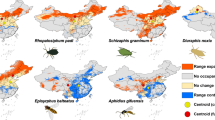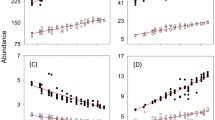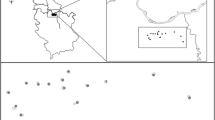Abstract
Changes in land use affect species interactions and population dynamics by modifying the spatial template of trophic interaction and the availability of resources in time and space. We developed a process-based spatially explicit model for evaluating the effects of land use on species viability by modelling foraging performance and energy sequestration in a stage structured, three-trophic population model. The model is parameterized with realistic parameters for a ladybeetle–aphid–host plant interaction, and is run in four realistic landscapes in the Czech Republic. We analysed whether changes in crop selection and fertilizer input could explain the dramatic and unexplained decline in abundance of the ladybeetle Coccinella septempunctata in the Czech Republic from 1978 to 2005. The results indicate that a major reduction in fertilizer input after the transition to a market economy, resulting in lower aphid population densities in cereal crops and negatively affecting energy sequestration, survival and reproduction of ladybeetles, provides a sufficient explanation for the observed population decline. Simulations further indicated that the population viability of C. septempunctata is highly dependent on availability of aphid prey in crops, in particular cereal, which serves as their major reproduction habitat. The results demonstrate how the abundance of naturally occurring predators, which are instrumental for biological pest control, depends upon the spatial resource template that are provided at the landscape scale.







Similar content being viewed by others
References
Anonymous (2003) Statistical yearbook of the Czech Republic. Czech Statistical Institute, Prague
Anonymous (2006) Statistical yearbook of the Czech Republic. Czech Statistical Institute, Prague
Arrignon F, Deconchat M, Sarthou JP, Balent G, Monteil C (2007) Modelling the overwintering strategy of a beneficial insect in a heterogeneous landscape using a multi-agent system. Ecol Mod 205:423–436
Bianchi FJJA, Booij CJH, Tscharntke T (2006) Sustainable pest regulation in agricultural landscapes: a review on landscape composition, biodiversity and natural pest control. Proc R Soc B 273:1715–1727
Bianchi FJJA, van der Werf W (2003) The effect of the area and configuration of hibernation sites on the control of aphids by Coccinella septempunctata (Coleoptera: Coccinellidae) in agricultural landscapes: a simulation study. Environ Entomol 32:1290–1304
Corbett A, Plant RE (1993) Role of movement in the response of enemies to agroecosystem diversification: a theoretical evaluation. Environ Entomol 22:519–531
Costamagna AC, van der Werf W, Bianchi FJJA, Landis DA (2007) Predictive model for Aphis glycines (Hemiptera: Aphididae) growth based on field populations. Agric For Entomol (in press)
Duelli P, Obrist MK (2003) Regional biodiversity in an agricultural landscape: the contribution of seminatural habitat islands. Basic Appl Ecol 4:129–138
Duffield SJ, Bryson RJ, Young JEB, Sylvester-Bradley R, Scott RK (1997) The influence of nitrogen fertiliser on the population development of the cereal aphids Sitobion avenae (F.) and Metopolophium dirhodum (Wlk.) on field grown winter wheat. Ann Appl Biol 130:13–26
Elliott NC, Kieckhefer RW, Beck DA (2000) Adult coccinellid activity and predation on aphids in spring cereals. Biol Control 17:218–226
Elliott NC, Kieckhefer RW, Lee JH, French BW (1998) Influence of within-field and landscape factors on aphid predator populations in wheat. Landscape Ecol 14:239–252
Forman RTT (1995) Land mosaics: the ecology of landscapes and regions. Cambridge University Press, Cambridge
Fryxell JM, Wilmshurst JF, Sinclair ARE, Haydon DT, Holt RD, Abrams PA (2005) Landscape scale, heterogeneity, and the availability of Serengeti grazers. Ecol Lett 8:328–335
Grünbaum D (1998) Using spatially explicit models to characterize foraging performance in heterogeneous landscapes. Am Nat 151:97–115
Halley JM, Thomas CFG, Jepson PC (1996) A model for the spatial dynamics of linyphiid spiders in farmland. J Appl Ecol 33:471–492
Hasken KH, Poehling HM (1995) Effects of different densities of fertilisers and pesticides on aphids and aphid predators in winter wheat. Agric Ecosyst Environ 107:145–150
Hodek I (1996) Food relationships. In: Hodek I, Honĕk A (eds) Ecology of Coccinellidae. Kluwer Academic Publishers, Dordrecht, pp 143–238
Hodek I, Iperti G, Hodkova M (1993) Long-distance flights in Coccinellidae (Coleoptera). Eur J Entomol 90:403–414
Honĕk A (1980) Population density of aphids at the time of settling and ovariole maturation in Coccinella septempunctata (Col.: coccinellidae). Entomophaga 25:427–430
Honĕk A (1982) The distribution of overwintered Coccinella septempunctata (Col., Coccinellidae) adults in agricultural crops. Z Ang Entomol 94:311–319
Honĕk A (1989) Overwintering and annual changes of abundance of Coccinella septempunctata in Czechoslovakia (Coleoptera, coccinellidae). Acta Entomol Bohemoslov 86:179–192
Honĕk A (1991) Nitrogen fertilization and abundance of the cereal aphids Metopolophium dirhodum and Sitobion avenae (Homoptera, aphididae). J Plant Dis Prot 98:655–660
Honĕk A (1997) Factors determining winter survival in Coccinella septempunctata (Col.: Coccinellidae). Entomophaga 42:119–124
Honĕk A, Martinkova Z (2005) Long-term changes in abundance of Coccinella septempunctata (Coleoptera: Coccinellidae) in the Czech Republic. Eur J Entomol 102:443–448
Ives AR, Kareiva P, Perry R (1993) Response of a predator to variation in prey density at three hierarchical scales: lady beetles feeding on aphids. Ecology 74:1929–1938
Kareiva P, Odell G (1987) Swarms of predators exhibit prey taxis if individual predators use area-restricted search. Am Nat 130:233–270
Kareiva P, Wennergren U (1995) Connecting landscape patterns to ecosystem and population processes. Nature 373:299–302
Lipa JJ, Pruszynski S, Bartkowski J (1975) The parasites and survival of the ladybird beetles (Coccinellidae) during winter. Acta Parasit Pol 23:453–461
Matis JH, Kiffe TR, Matis TI, Stevenson DE (2005) Nonlinear stochastic modeling of aphid population growth. Math Biosc 198:148–168
Murrell DJ, Law R (2000) Beetles in fragmented woodlands: a formal framework for dynamics of movement in ecological landscapes. J Anim Ecol 69:471–483
Osawa N (2000) Population field studies on the aphidophagous ladybird beetle Harmonia axyridis (Coleoptera: Coccinellidae): resource tracking and population characteristics. Pop Ecol 42:115–127
Rand TA, Tylianakis JM, Tscharntke T (2006) Spillover edge effects: the dispersal of agriculturally subsidized insect natural enemies into adjacent natural habitats. Ecol Lett 9:603–614
Thorbek P, Topping CJ (2005) The influence of landscape diversity and heterogeity on spatial dynamics of agrobiont linyphiid spiders: an individual-based model. Biocontrol 50:1–33
Tscharntke T, Klein AM, Kruess A, Steffan Dewenter I, Thies C (2005) Landscape perspectives on agricultural intensification and biodiversity – ecosystem service management. Ecol Lett 8:857–874
Van der Werf W, Evans EW, Powell J (2000) Measuring and modelling the dispersal of Coccinella septempunctata (Coleoptera: Coccinellidae) in alfalfa fields. Eur J Entomol 97:487–493
Williams IS, van der Werf W, Dewar AM, Dixon AFG (1999) Factors affecting the relative abundance of two coexisting aphid species on sugar beet. Agr For Entomol 1:119–125
With KA, Pavuk DM, Worchuck JL, Oates RK, Fisher JL (2002) Threshold effects of landscape structure on biological control in agroecosystems. Ecol Appl 12:52–65
Xia JY, Rabbinge R, van der Werf W (2003) Multistage functional responses in a ladybeetle-aphid system: scaling up from the laboratory to the field. Environ Entomol 32:151–162
Xia JY, van der Werf W, Rabbinge R (1999) Temperature and prey density on bionomics of Coccinella septempunctata (Coleoptera: Coccinellidae) feeding on Aphis gossypii (Homoptera: Aphididae) on cotton. Environ Entomol 28:307–314
Wu JG, Hobbs R (2002) Key issues and research priorities in landscape ecology: an idiosyncratic synthesis. Landsc Ecol 17:355–365
Zhou X, Carter N, Powell W (1994) Seasonal distribution and aerial movement of adult coccinellids on farmland. Biocontrol Sc Technol 4:167–175
Zollner PA, Lima SL (1999) Search strategies for landscape-level interpatch movements. Ecology 80:1019–1030
Acknowledgements
This research was supported by the Stimulation Program Biodiversity of the Dutch Organization for Scientific Research, the DWK Program 352 of the Dutch Ministry of Agriculture, Nature and Food Quality and Grant No. 522/05/0765 of the Grant Agency of the Czech Republic.
Author information
Authors and Affiliations
Corresponding author
Rights and permissions
About this article
Cite this article
Bianchi, F.J., Honĕk, A. & van der Werf, W. Changes in agricultural land use can explain population decline in a ladybeetle species in the Czech Republic: evidence from a process-based spatially explicit model. Landscape Ecol 22, 1541–1554 (2007). https://doi.org/10.1007/s10980-007-9145-z
Received:
Accepted:
Published:
Issue Date:
DOI: https://doi.org/10.1007/s10980-007-9145-z




